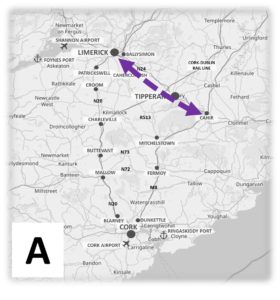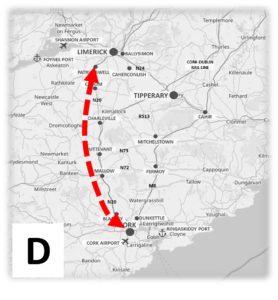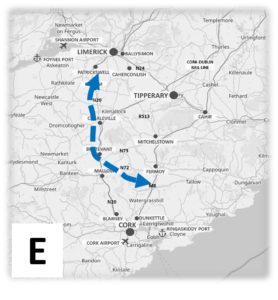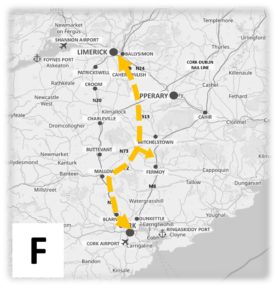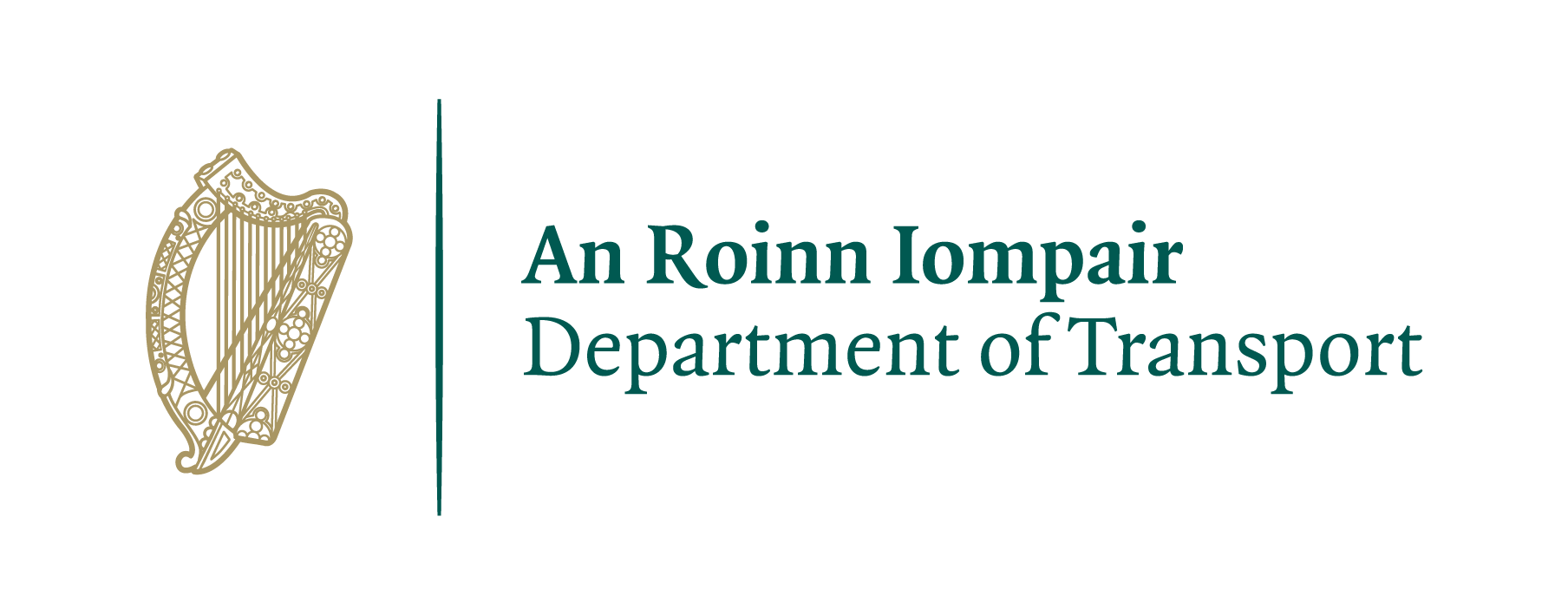Feb 2020 Update
February 2020
The work to date has focused on examining various road-based and rail-based scenarios for improving transport connections between Cork and Limerick. Whilst all of the road-based scenarios examined have the potential to improve connectivity, the appraisal work concluded that the road-based scenario running in the broad N20 corridor via Charleville and Mallow performs best overall in relation to the project objectives and is the preferred road-based scenario. Rail-based scenarios involving improved service frequency with either through services at Limerick Junction or alternatively provision of a new direct line between Charleville and Limerick have been identified for further appraisal in the next phase of work.
Phase 1 is an important stage as it defines the concept for the scheme to be developed and confirms its potential to achieve project aims. The project team have used an objective-based appraisal to consider a number of high-level strategic transport improvement scenarios that could address existing and future anticipated problems in the network between Cork and Limerick. The objectives have been formulated by defining the deficiencies in the existing network, in particular the N20 national primary route which is predominately single carriageway. Route capacity, recurrent congestion in urban areas and a high record of severe accidents are of particular concern.
Road-Based Scenarios
Seven road-based scenarios have been identified based upon providing a new high-quality road between key nodes at Cork (the N20 at Blarney and the N25 at Dunkettle) and Limerick (the M20 at Patrickswell and the N24 at Ballysimon). A number of the scenarios use sections of the existing M8 motorway to the north of Dunkettle. All scenarios are based on preserving the existing road network to provide local access to communities. Grade-separated junctions along the new route would provide for strategic access and interchange with the local road network. The seven road-based scenarios are shown in Figures 1 to 7 below.
Figure 1: Road-Based Scenario A (new route in N24 corridor from Cahir to Ballysimon)
Figure 2: Road-Based Scenario B (new route in R513 corridor from M8 at Mitchelstown to Ballysimon)
Figure 3: Road-Based Scenario C (new route in R512 and N20 corridors from M8 at Mitchelstown to Patrickswell)
Figure 4: Road-Based Scenario D (new route in N20 corridor from Blarney to Patrickswell)
Figure 5: Road-Based Scenario E (new route in N72 and N20 corridors from Fermoy to Patrickswell)
Figure 6: Road-Based Scenario F (new route in N20, R513 and N24 corridors from Blarney to Ballysimon with spur to M8 at Mitchelstown)
Figure 7: Road-Based Scenario G (new route in R513 and N24 corridors from Mitchelstown to Ballysimon)
The National Transport Model has been used to predict the level of traffic that would transfer onto each of the proposed road-based scenarios and thereby provide traffic relief to urban areas experiencing the environmental impacts of through traffic. The modelling is also able to predict the improvement in journey time between Cork and Limerick, which is a key metric in determining the performance of the scenarios, particularly with respect to economic opportunities created in efficiently connecting the two cities.
The performance of each of the road-based scenarios has been appraised using Multi-Criteria Analysis (MCA) in relation to the 17 project objectives listed under the Project Objectives to determine the best performing road-based scenario. The MCA framework and further explanation of the methods used are contained in Technical Note 1: Phase 1 Multi-Criteria Analysis.
Whilst all road-based scenarios have the potential to improve connectivity between Cork and Limerick, the appraisal concluded that the road-based scenario running in the N20 corridor (Scenario D) performs best overall in relation to the project objectives and is the preferred road-based scenario.
The results of the appraisal confirm that the road-based scenario running in the N20 corridor (Scenario D):
- provides the highest journey time savings between Cork and Limerick
- has the potential to save the greatest number of road-based collisions across the network
- public transport service times and reliability would improve and there would be an opportunity to use the new route for express inter-city bus services
- has the greatest transfer of traffic from the existing road network onto the new scenario
- provides the highest level of traffic relief to towns and villages
- provides a step change in connectivity between Cork and Limerick, as well as improving connectivity for the regional towns along the corridor
- provides the opportunity to grow the Atlantic Economic Corridor by improving connections to west Cork and Kerry
- provides good opportunities for connection to existing and proposed public transport interchanges
- enables opportunities for walking and cycling activity in towns and villages due to reduced traffic levels
The preferred road-based scenario will be carried forward to Phase 2 Option Selection.
The Public Spending Code requires consideration of all potential options including public transport alternatives. Road-based public transport, including buses, are considered as part of the road-based scenarios. Rail-based public transport is considered with the following rail-based scenarios.
Rail-Based Scenarios
There are two rail-based scenarios which are shown in Figures 8 and 9 and described below.
Figure 8: Rail-Based Scenario 1 (Existing Cork to Limerick Rail Line)
Rail-Based Scenario 1 (RS1) – Existing Cork to Limerick Rail Line – this scenario proposes to double the frequency of Cork to Limerick train services to half-hourly by introducing a new direct service on the existing lines leaving Cork 30 minutes after the Dublin train, which will continue to stop and allow transfer to Limerick at Limerick Junction. The recently completed works at Limerick Junction would allow the direct service to pass through at-grade without any conflict with other services. The new service would stop at Mallow, Charleville and Limerick Junction but passengers would not be required to change trains at Limerick Junction like they do now.
Figure 9: Rail-Based Scenario 2 (New Rail Line Charleville to Limerick)
Rail-Based Scenario 2 (RS2) – New Rail Line Charleville to Limerick – this scenario would involve the provision of a new railway connection between Charleville and Limerick. This would allow a new hourly service to leave Cork on the half hour and arrive in Limerick using the existing line between Cork and Charleville and then the proposed new line between Charleville and Limerick. The new line could connect into the existing Limerick to Dublin line outside the Limerick metropolitan area to utilise the existing line into Limerick station. The new service would have intermediate stops at Mallow and Charleville.
The two rail-based scenarios will be carried forward to Phase 2 Option Selection.


